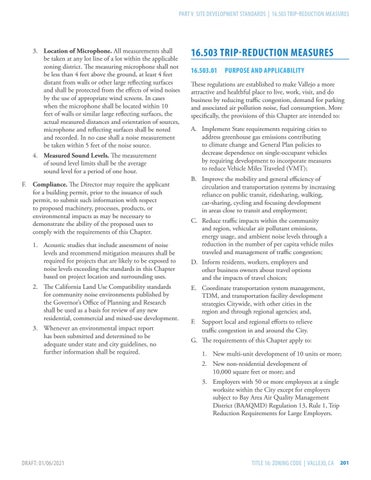Part V Site Development Standards | 16.503 Trip-Reduction Measures
3. Location of Microphone. All measurements shall be taken at any lot line of a lot within the applicable zoning district. The measuring microphone shall not be less than 4 feet above the ground, at least 4 feet distant from walls or other large reflecting surfaces and shall be protected from the effects of wind noises by the use of appropriate wind screens. In cases when the microphone shall be located within 10 feet of walls or similar large reflecting surfaces, the actual measured distances and orientation of sources, microphone and reflecting surfaces shall be noted and recorded. In no case shall a noise measurement be taken within 5 feet of the noise source. 4. Measured Sound Levels. The measurement of sound level limits shall be the average sound level for a period of one hour. F. Compliance. The Director may require the applicant for a building permit, prior to the issuance of such permit, to submit such information with respect to proposed machinery, processes, products, or environmental impacts as may be necessary to demonstrate the ability of the proposed uses to comply with the requirements of this Chapter. 1. Acoustic studies that include assessment of noise levels and recommend mitigation measures shall be required for projects that are likely to be exposed to noise levels exceeding the standards in this Chapter based on project location and surrounding uses.
16.503 TRIP-REDUCTION MEASURES 16.503.01  PURPOSE AND APPLICABILITY These regulations are established to make Vallejo a more attractive and healthful place to live, work, visit, and do business by reducing traffic congestion, demand for parking and associated air pollution noise, fuel consumption. More specifically, the provisions of this Chapter are intended to: A. Implement State requirements requiring cities to address greenhouse gas emissions contributing to climate change and General Plan policies to decrease dependence on single-occupant vehicles by requiring development to incorporate measures to reduce Vehicle Miles Traveled (VMT); B. Improve the mobility and general efficiency of circulation and transportation systems by increasing reliance on public transit, ridesharing, walking, car-sharing, cycling and focusing development in areas close to transit and employment; C. Reduce traffic impacts within the community and region, vehicular air pollutant emissions, energy usage, and ambient noise levels through a reduction in the number of per capita vehicle miles traveled and management of traffic congestion; D. Inform residents, workers, employers and other business owners about travel options and the impacts of travel choices;
2. The California Land Use Compatibility standards for community noise environments published by the Governor’s Office of Planning and Research shall be used as a basis for review of any new residential, commercial and mixed-use development.
E. Coordinate transportation system management, TDM, and transportation facility development strategies Citywide, with other cities in the region and through regional agencies; and,
3. Whenever an environmental impact report has been submitted and determined to be adequate under state and city guidelines, no further information shall be required.
G. The requirements of this Chapter apply to:
F. Support local and regional efforts to relieve traffic congestion in and around the City. 1. New multi-unit development of 10 units or more; 2. New non-residential development of 10,000 square feet or more; and 3. Employers with 50 or more employees at a single worksite within the City except for employers subject to Bay Area Air Quality Management District (BAAQMD) Regulation 13, Rule 1, Trip Reduction Requirements for Large Employers.
Draft: 01/06/2021
TITLE 16: ZONING CODE | VALLEJO, CA 201







